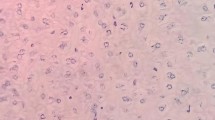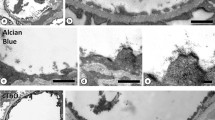Synopsis
By application of appropriate blocking reactions (acetylation, de-amination, methylation and NaHSO3-treatment) it is demonstrated that the tissue ligands involved in the selective glycogen contrast staining reaction with the OsVI. FeII complex (known to be present in the combination K2OsO K4 4Fe(CN)6) are the glycogen C2−C3 di-hydroxyl groups. Deliberate conversion of the diols into di-aldehydes and (di-)carboxyl groups by the application of specific oxidative agents followed, by application of the OsVI.FeII-complex results morphologically in identical selective contrast staining of glycogen.
By applying appropriate blocking reactions to such pre-oxidized aldehyde fixed glycogen, evidence is accumulated that K2OsO4 and K3Fe(CN)6 are unable to oxidize diols, whereas OsO4 and H2O2 are able to convert diols into carboxyl groups.
From these results it is concluded that in the combination K2OsO K4 4Fe(CN)6 the OsVI.FeII complex reacts with unchanged diols in the glycogen, whereas the OsO4 in the combination OsO K4 4Fe(CN)6 can petentially create carboxyl groups in the aldehydefixed glycogen.
The addition of urea to the two glycogen contrasting combinations (K2OsO K4 4Fe(CN)6 or OsO K4 4Fe(CN)6), also emphasizes that, although morphologically both combinations produceidentical contrast stained glycogen, chemically the contrast staining is apparently obtained in a different way, as urea prevented the contrast for mation in the glycogen by the combination K2OsO K4 4Fe(CN)6, but not by the combination OsO K4 3Fe(CN)6.
Similar content being viewed by others
References
Angyal, S. J. &James, K. (1971). Oxidation of carbohydrates with chromium trioxide in acetic acid. II. Acetals, a new synthesis of ketoses.Aust. J. Chem. 24, 1219–27.
De Bruijn, W. C. (1973). Glycogen, its chemistry and morphologic appearance in the electron microscope. I. A modified OsO4 fixative which selectively contrasts glycogen.J. Ultrastruct. Res. 42, 29–50.
De Bruijn, W. C. &Den Breejen, P. (1973). Selective glycogen contrast by hexavalent osmium oxide compounds. In.Electron Microscopy and Cytochemistry (eds. E. Wisse, W. Th. Daems, I. Molenaar & P. van Duijn)., pp. 259–62. Amsterdam, North-Holland.
De Bruijn, W. N. &Den Breejen, P. (1975). Glycogen, its chemistry and morphological appearance in the electron microscope. II. The complex formed in the selective contrast staining of glycogen.Histochem. J. 7, 205–29.
Cogliati, R. &Gautier, A. (1973). Mise en évidence de l'ADN et des polysaccharides à l'aide d'un nouveau réactif'de type Schiff.C. r. Acad. Sci. Paris, Série D 276, 3041–4.
Collin, R. J. &Griffith, W. P. (1974). Mechanism of tissue component staining by osmium tetroxide.J. Histochem. Cytochem. 22, 992–3.
Criegée, R., Marchand, B. &Wannowius, H. (1942). Zur Kenntnis der organischen Osmiumverbindungen.Ann. Chem. 550, 98–104.
Dvoràk, A. M., Hammond, M. E., Dvoràk, H. F. &Karnovsky, M. J. (1972). Loss of cell surface material from peritoneal exudate cells associated with lymphocyte-mediated inhibition of macrophage migration from capillary tubes.Lab. Invest. 27, 561–74.
Finar, I. L. (1965).Organic Chemistry, Vol. I New York: John Wiley.
Gautier, A., Cogliati, R., Schreyer, M. &Fakan, J. (1973) ‘Feulgen-type’ and ‘PAS-type’ reactions at the ultrastructural level. InElectron Microscopy and Cytochemistry (eds. E. Wisse, W. Th. Daems, I. Molenaar & P. van Duijn), pp. 271–4. Amsterdam: North-Holland.
Geddes, R. (1971). Studies on native glycogen. 2. Observations on metabolic inhomogeneity.Int. J. Biochem. 2, 657–60.
Gottschalk, A. &Bhargava, A. S. (1972). Submaxillary gland glycoproteins. In:Glycoproteins. Their composition, structure, and function (ed. A. Gottschalk), pp. 810–25. Amsterdam, London, New York: Elsevier.
Green, J. W. (1957). Acids and oxidation products. In:The Carbohydrates. Chemistry, Biochemistry, Physiology (ed. W. Pitman). New York: Academic Press.
Horobin, R. W. &Murgatroyd, L. B. (1971). The staining of glycogen with Best's carmine and similar hydrogen bonding dyes. A mechanistic study.Histochem. J. 3, 1–9.
Kent, P. W. (1967). Structure and function of glycoprotein. In:Essays in Biochemistry, Vol. III (eds. P. N. Campbell & G. D. Greville), pp. 109–13. New York, London: Academic Press.
Kugler, J. H. (1967). Correlation of the glycogen concentration in rat liver and the appearance of glycogen and agranular endoplasmic reticulum.J. R. microsc. Soc. 86, 285–96.
Lillie, R. D. (1954).Histopathologic Technic and Practical Histochemistry, pp. 160, 161, 275. New York: McGraw-Hill.
Litman, R. B. &Barrnett, R. J. (1972). The mechanism of the fixation of tissue components by osmium tetroxide via hydrogen bonding.J. Ultrastruct. Res. 38, 63–86.
Lomako, J. (1971). The role of protein in the structure of glycogen.Acta Biochim. Polon. 18, 261–9.
Malinin, G. I. (1970). Metachromatic staining of sodium bisulfide addition derivative of glycogen.J. Histochem. Cytochem. 18, 834–41.
Meyer, F., Heilmeyer, L. M. G., Haschke, R. H. &Fischer, E. R. (1970). Control of phosphorylase activity in a muscle glycogen particle. I. Isolation and characterization of the protein-glycogen complex.J. biol. Chem. 245, 6642–8.
Millonig, G. &Marinozzi, V. (1968). Fixation and embedding in electron microscopy. In:Advances in Optical and Electron Microscopy, Vol. II (eds. R. Barer & V. E. Cosslett), pp. 251–336. London, New York: Academic Press.
Moody, G. J. (1964). The action of hydrogen peroxide on carbohydrates and related compounds.Adv. Carbohydrate Chem. 19, 149–79.
Murgatroyd, L. B. (1970). Mechanism of glycogen staining by Best's carmine and other dyes.J. Med. Lab. Technol. 27, 512–27.
Ovadia, M. &Stoward, P. J. (1971). Some quantitative histochemical studies on the periodic acid oxidation of glycogenin situ.Histochem. J. 3, 233–40.
Pearse, A. G. E. (1960).Histochemistry. Theoretical and Applied, Vol. I, 2nd Edn, pp. 617, 243, 832. London: Churchill.
Pearse, A. G. E. (1972).Histochemistry. Theoretical and Applied, Vol. II, 3rd Edn, pp. 1275–6. London: Churchill Livingstone.
Rambourg, A. (1973). Staining of intracellular glycoproteins. In:Electron Microscopy and Cytochemistry (eds. E. Wisse, W. Th. Daems, I. Molenaar & P. van Duijn), pp. 245–53. Amsterdam: North-Holland.
Rappay, G. Y. &Van Duijn, P. (1965). Chlorous acid as an agent for blocking tissue aldehydes.Stain Technol. 40, 275–7.
Schade, H. A. R. (1973). On the staining of glycogen for electron microscopy with polyacids of tungsten and molybdenum. I. Direct staining of sections of osmium-fixed and Epon-embedded mouse liver with aqueous solutions of phosphotungstic acid (PTA). In:Electron Microscopy and Cytochemistry (eds. E. Wisse, W. Th. Daems, I. Molenaar & P. van Duijn), pp. 263–6. Amsterdam North-Holland.
Seligman, A. M., Wasserkrug, H. L. &Hanker, J. S. (1966). A new staining method (OTO) for enhancing contrast of lipid-containing membranes and droplets in osmium tetroxide-fixed tissue with osmophilic thiocarbohydrazide (TCH).J. Cell Biol. 30, 424–32.
Sharon, N. (1974). Glycoproteins.Scient. Am. 230, 78–86.
Thiéry, J.-P. (1967). Mise en évidence des polysaccharides sur coupes fines en microscopie électronique.J. Microscopie 6, 987–1018.
Venable, J. H. &Coggeshall, R. (1965). A simplified lead citrate stain for use in electron microscopy.J. Cell Biol. 25, 407–8.
Wanson, J.-C. &Drochmans, P. (1968). Rabbit skeletal muscle glycogen. A morphological study of glycogen β-particles isolated by the precipitation-centrifugation method.J. Cell Biol. 38, 130–49.
Wanson, J.-C., Drochmans, P. &Mosselmans, R. (1970). Intervention du reticulum sarcoplasmique dans le metabolism du glycogene. In:Microscopie électronique; 7th Intern. Congress, Grenoble, Vol. III (ed. P. Favard), pp. 791–2. Paris: Société Français de Microscopie électronique.
Watson, M. L. (1958). Staining of tissue sections for electron microscopy with heavy metals.J. biophys. biochem. Cytol. 4, 475–8.
Author information
Authors and Affiliations
Rights and permissions
About this article
Cite this article
De Bruijn, W.C., Den Breejen, P. Glycogen, its chemistry and morphological appearance in the electron microscope. III. Identification of the tissue ligands involved in the glycogen contrast staining reaction with the osmium (VI)-iron(II) complex. Histochem J 8, 121–142 (1976). https://doi.org/10.1007/BF01007164
Received:
Revised:
Issue Date:
DOI: https://doi.org/10.1007/BF01007164




